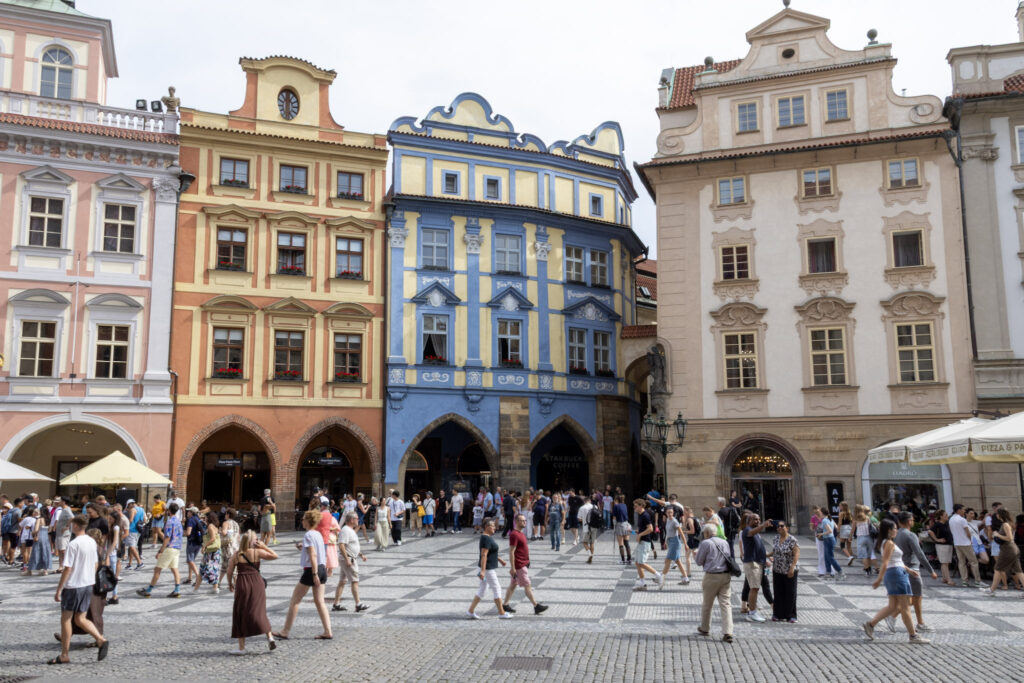
I feel wealthy because I have accumulated friendships that have withstood time. Niah is one such friendship, a person who knows about the time I sh** my pants, my extensive list of ex boyfriends, and my show choir phase. That friend who knows your fake laugh or can call you in tears at 4am from a hostel in Barcelona. A friend who transcends that boundary into the tightly secured territory reserved for close family.
When Niah shared that she was traveling to Europe this summer, we decided to base our travel on Prague as it was within reach of her childhood dream of another country all entirely. That country was not the Czech Republic, but rather Liechtenstein, the world’s sixth smallest nation, about 4 miles wide and 16 miles long, and one of the least visited countries in Europe.
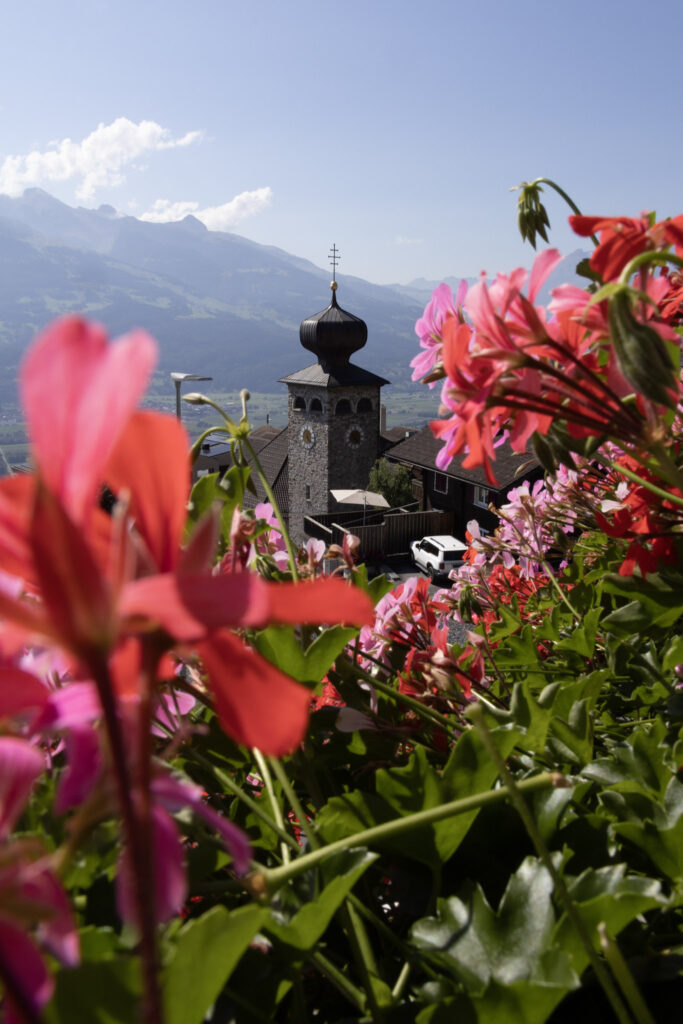

“Liechtenstein? There’s nothing there!” My Swiss family and friends would exclaim when I shared that we would travel first to Niah’s dream country of Liechtenstein, then take a series of what would become 15 hours’ worth of trains to Prague. I couldn’t tell what baffled those around me most: the aspect of taking eight trains to Prague, or spending vacation time in Liechtenstein.
Unlike most holidays where I plan an activity-packed agenda minute-by-minute, our four days in Prague were spent catching up over her tea, my coffee, watching fire breathers and belly dancers at a medieval dinner, and walking through a city that combines quintessential European cobblestones and pastel dollhouse-like architecture with cubist statues at every corner.
- Sleeping Among Knights at the Pytloun Old Armoury Hotel
- The Bridge That Comes Alive at Night
- Concrete, Cold War, and Blue Denim Jeans
- The Quarter That Hitler Couldn’t Erase
- The Beauty and the Beast Library of Prague
- Bean Bag Chairs on a Rooftop: Prague’s Sunset Cinema
- Prague’s Wes Anderson Moment: Hlavní Nádraží
Sleeping Among Knights at the Pytloun Old Armoury Hotel

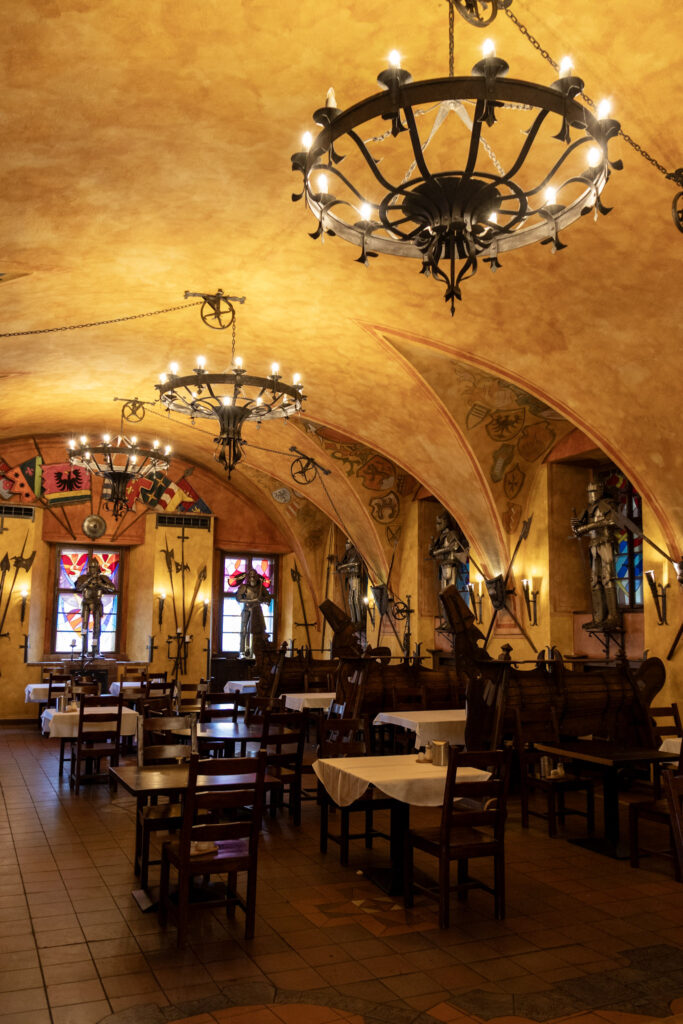
“It’s just enough clean, but just enough weird,” Niah said when we browsed online for hotels in Prague.
Staying at the Pytloun Old Armoury Hotel is like a night in a museum, complete with a large banquet hall with armored knights at the entrances and shields and swords pinned to the walls. While the history of the hotel is not noted on its website, it is centrally located within Prague’s historic quarter, a few steps from the Lennon Wall and Charles Bridge.
Complaints on TripAdvisor (looking at you Rob and Helena) seem to stem from the lack of air conditioning, however I am used to this living in Switzerland (read about that here).
Address: Všehrdova 450, Nosticova 634 parking | Website: https://www.pytlounoldarmouryhotel.cz/en/
The Bridge That Comes Alive at Night
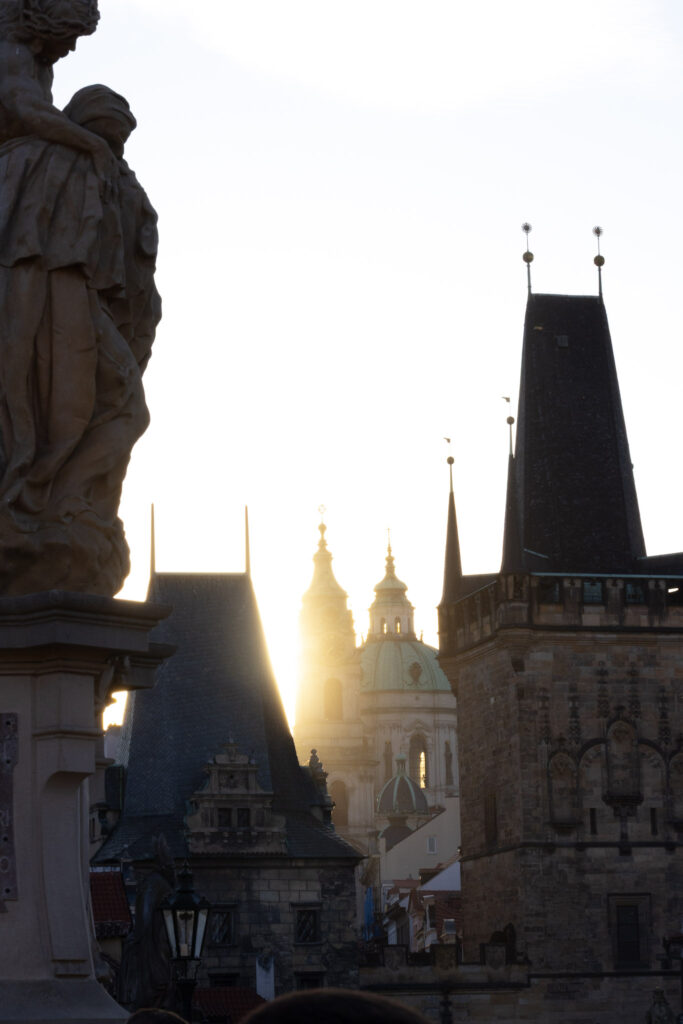

While we joined the herds of tourists walking across Charles Bridge, the July sun beating down on us like ants to a magnifying glass, something about the popularity of Charles Bridge took away from the experience.
During the day, so many tourists clogged up the cobblestones, that I wanted to sprint across, making it to the other side, OR cross over one of the other parallel bridges that lack in international recognition.
The Charles Bridge is old. Not Velcro shoes old, or fine lines and wrinkles old, but Middle Ages-old. Constructed in 1357, the bridge stands out from afar with its gothic entrance gate into the old city, blackened from age. Statues of saints built in the 16th and 17th centuries align the walkway, warning passersby to attend mass and repent for their sins.
Artists sell jewelry and paintings along the bridge; musicians I imagine can also make a small fortune during the high peak tourist season of July and August.
I didn’t understand the allure of the Charles Bridge until nightfall, when the full moon cast a soft glow over the river and the cobblestones, the statues illuminated by Victorian-style lamps in a scene that felt lifted straight from Hogwarts.
Concrete, Cold War, and Blue Denim Jeans
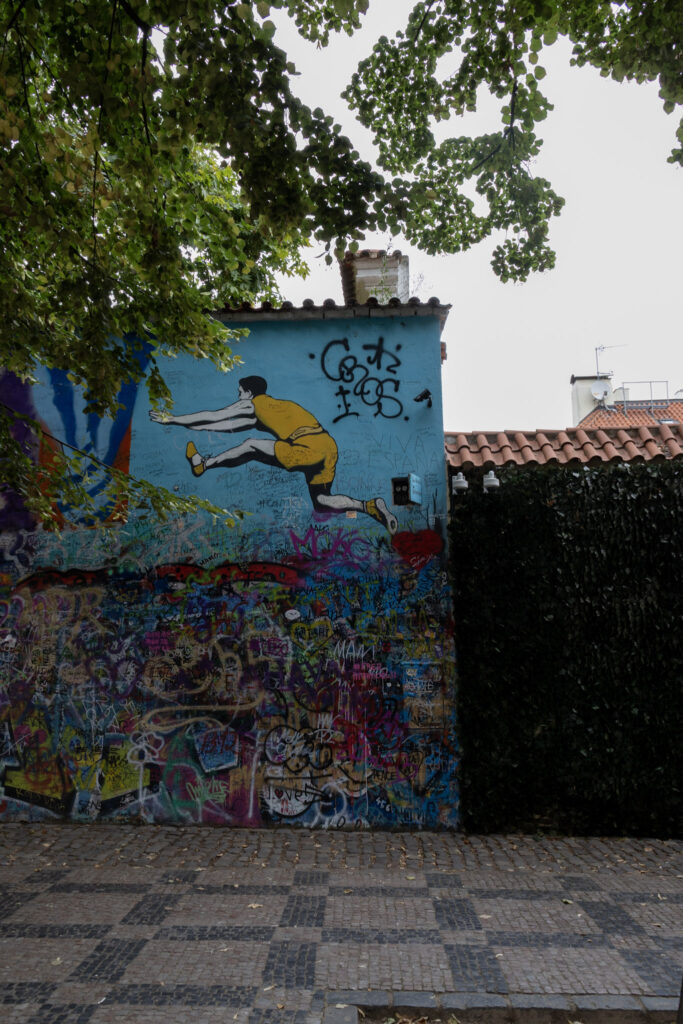
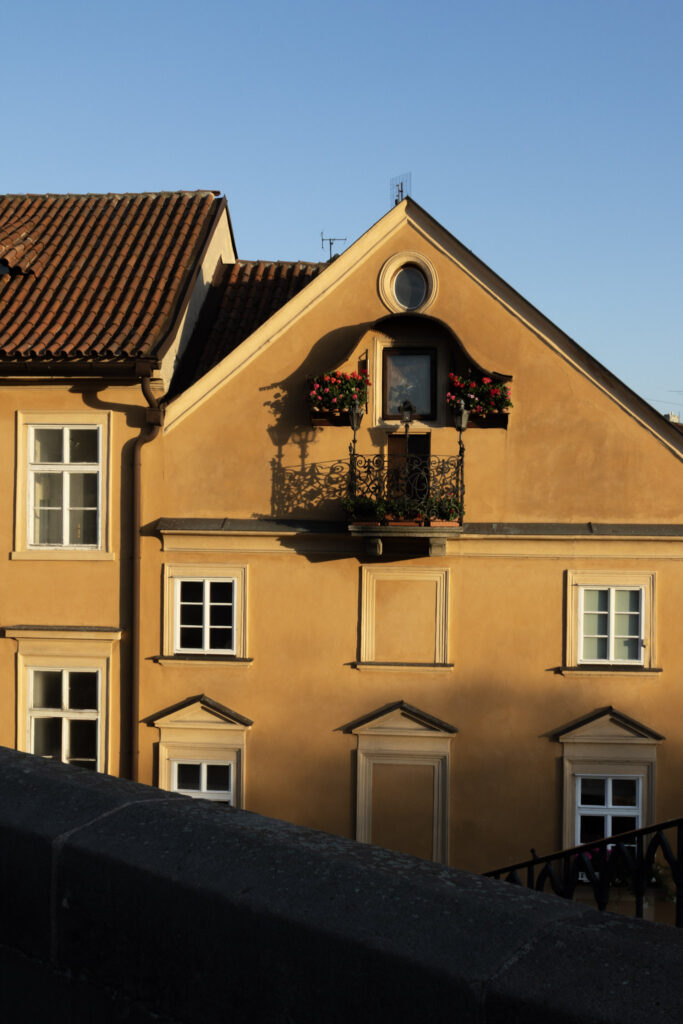
We found ourselves beneath Prague in one of the city’s 700 bunkers. The dusty air coated our throats as we sat in a damp, concrete chamber facing the blown-up bits of a giant replica of Joseph Stalin’s nose —an unloaded machine gun pointed towards the doorway.
“We’ve understood for a long time how to destroy this world 100 times over,” our guide said. Built in 1955, the space we filled had luckily never been used. A costly expenditure, Prague decided to keep it intact, given the war in Ukraine. 400,000 Ukranians now call Prague home.
I was inspired to book this spur of the moment tour thanks to being excluded in a morning coffee with coworkers from Prague, Poland and Russia.
“Oh dear, well, you see, we all grew up with communism,” my friend from Prague consoled me. She remembered the first time putting on jeans. In a similar vein, my friend from Bulgaria remembered the first McDonalds opening in her town. Everyone arrived early in freshly pressed suits.
I grew up with Pop-Tarts and Tang for breakfast. I could never understand communism.
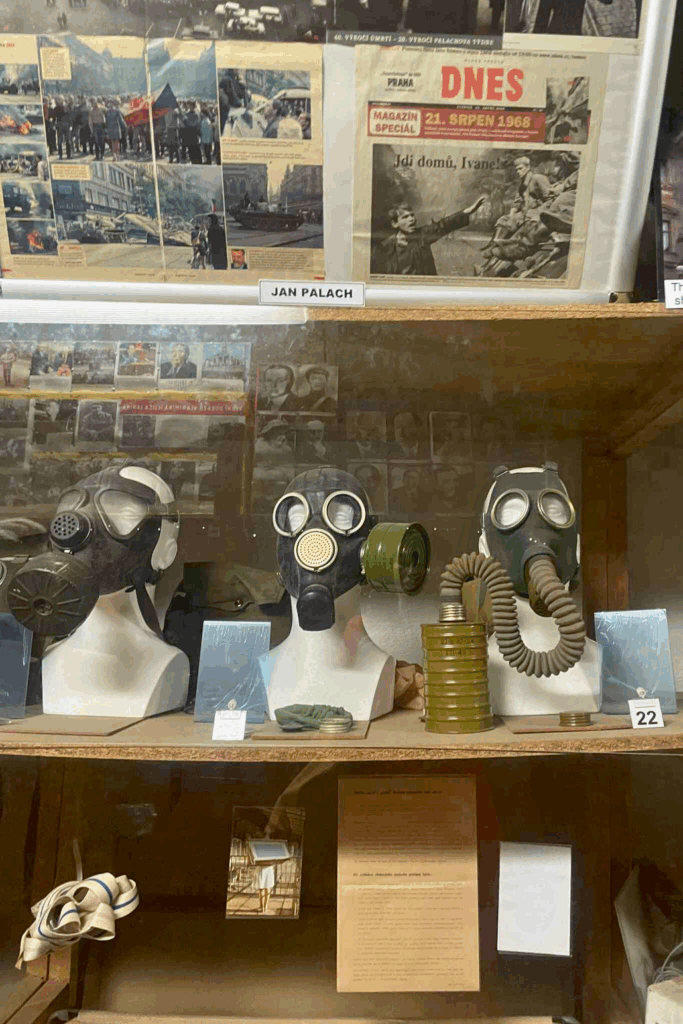
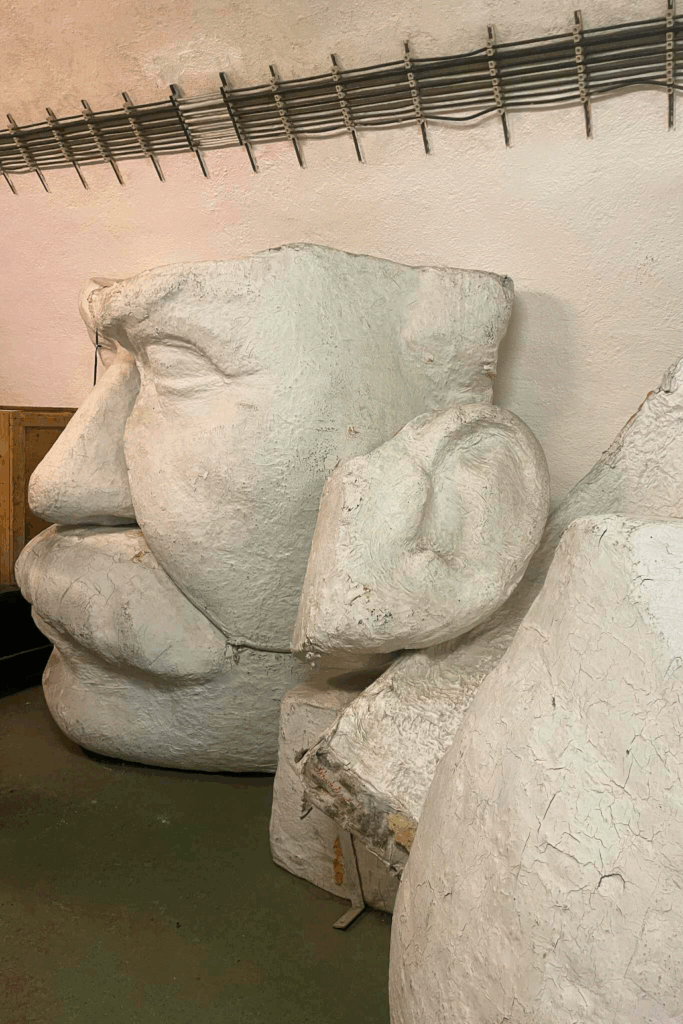
Our guide scratched his baseball cap, indicated “Stan” in cursive letters lest we forget his name. Silent for a moment, he shared that at one point he couldn’t explain to his young daughters why they weren’t able to drive 90 minutes in any direction to bordering Poland, Austria, Germany or Slovakia. Until the Velvet Revolution in 1989, those in the Czech Republic were not allowed to leave the country.
After the Second World War, Russia, led by the communist party, was seen as one of the liberators of Czechoslovakia. Anti-West sentiment was still at large, as the Czechs held a grudge against Germany, Britain, France and Italy following the 1939 Mnich Agreement, which annexed parts of Czechoslovakia to Nazi Germany. When elections were in full swing a year following the war, the communist party received 40% of votes. The next free election would be 44 years later.
Link to the tour | Communism and Nuclear Bunker Tour
The Quarter That Hitler Couldn’t Erase
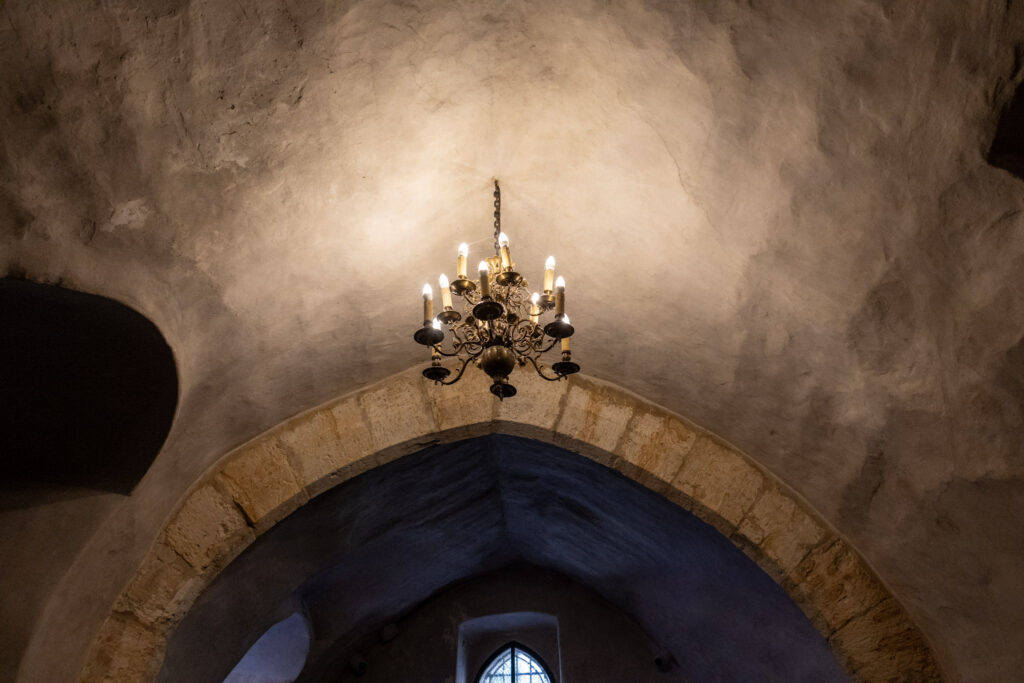
If you only have one day in Prague, I would highly recommend taking a tour of the Jewish ghetto, ideally with Peter, our guide who unintentionally extended what was to be a 2-hour tour to 4 hours. While we booked the tour via Viator, Peter, a history teacher with deep roots in Prague, has his own website for bookings here.
Our tour began in Josefov, also known as the Jewish Ghetto, or the Jewish Quarter. We walked upon golden tiles in front of homes, which we learned were names of former residents who had been sent to some of the 44,000 concentration camps that spread across Europe (many of which were constructed close to cities). Our guide’s wife’s family being some of those listed on the tiles.
Prague’s Jewish Quarter is one of the best preserved in the world, as Hitler intended to create a “Museum of an Extinct Race”. Artwork, books, and other belongings from deceased Jewish families throughout the country were sent to Prague to fill Hitler’s sick cultural agenda.
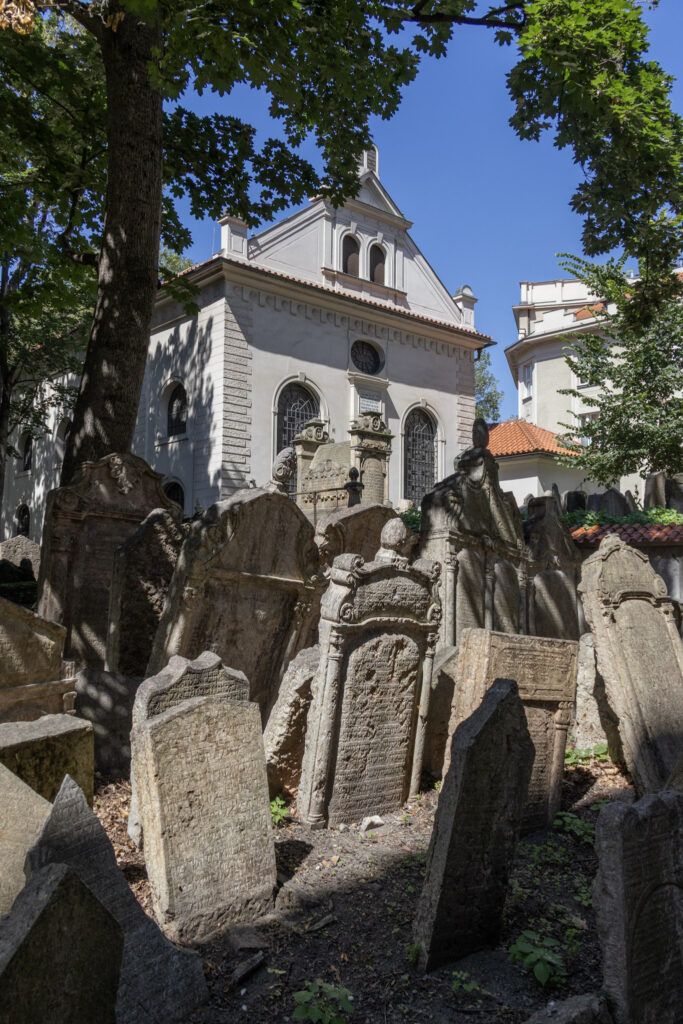
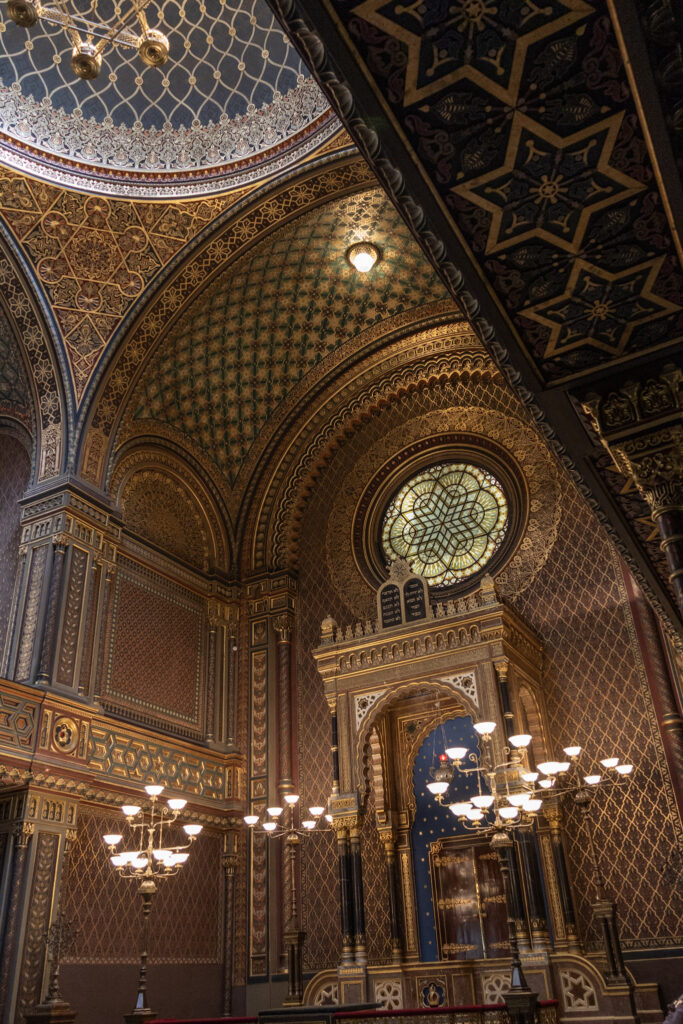
The tour covers several synagogues, beginning with the Maisel Synagogue, which displays numerous objects dating back to the 10th century. What struck me most here was a display of yellow badges that Jews were required to wear – yellow being a color that was easily seen but also having a negative connotation as being associated with the color of urine. In addition, you will visit the Pinkas Synagogue, which was transformed as a memorial for 80,000 victims of the Shoah. Walking into the bare building of thousands of names etched on stone is overwhelming, making those distant faces seem more real. The second floor also includes artwork by children, in case your heartstrings were not already snapped.
While the tour ended with the ornate Spanish Synagogue, that today also serves as a concert hall, my favorite location was Prague’s Old-New Synagogue, built in 1270 and what remains as Europe’s oldest active synagogue. The edifice is crafted in centuries of legends, with a locked attic where a clay creature brought to life by Rabbi Loew is said to hide. This creature, known as the Golem, was made in the 16th century to protect Prague’s Jewish community. That is, until the Golem became uncontrollable and dangerous, thus being locked away in the Old-New Synagogue. Today tourists can buy many clay Golems in the streets of Josefov, or even eat at the best restaurant we went to in Prague, which plays on the legendary name.
Link to the tour | Prague Jewish Quarter Walking Tour
The Beauty and the Beast Library of Prague
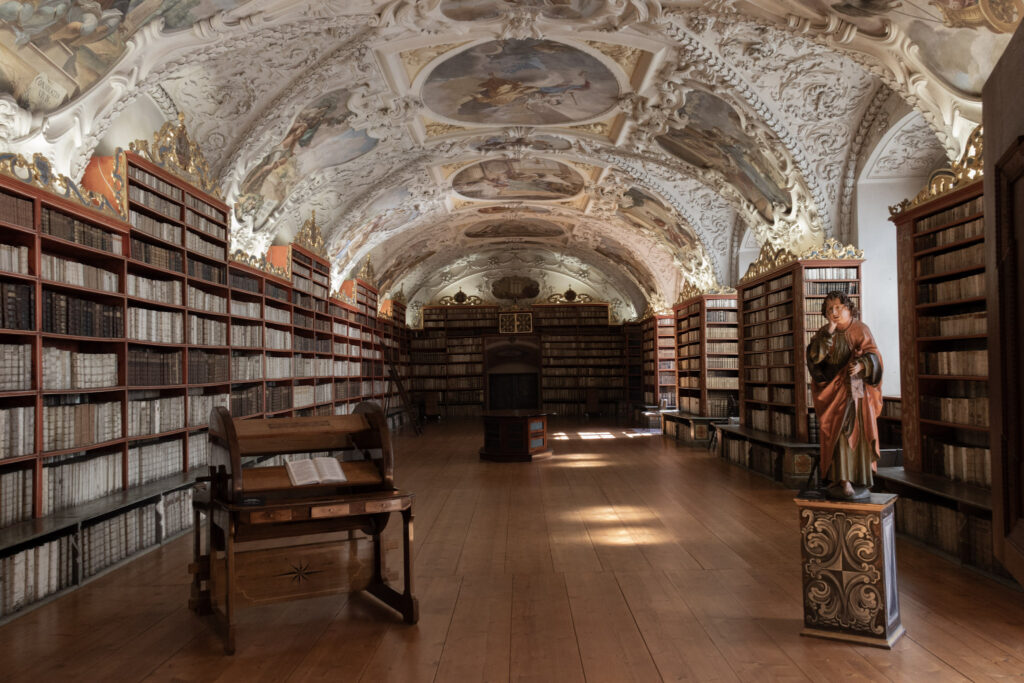
“Gallery! Gallery!” a smartly dressed woman in powder blue jumped as soon as we arrived at the last entry slot of the day. Like a triathlon athlete handing over a baton to her teammate, she shouted “Gallery! Gallery!” to her sharply dressed colleague in vibrant red, who showed us down a set of stairs, leading to an art gallery beneath the Strahov Monastery, first founded in 1143.
What drew us to the Strahov Monastery were its two spell bounding libraries. The first, known as the Theological Hall, was completed in 1679, and the second, the Philosophical Hall, in 1779.
Together, these pristine spaces house some 200,000 volumes, including around 1,500 first editions. Much like a prized 90s Beanie Baby collection—or the 2025 must-have labubus—the Strahov libraries are strictly off-limits, admired only from behind a gated window.
The view of Prague from atop the vineyard-covered hills outside of Strahov Monastery is well worth adding to your Prague itinerary. After visiting the Beauty and the Beast-like libraries and accomanying Cabinet of Curiosities, we headed downhill towards Prague, passing a nun chatting on her cell phone. A coffee truck sits alongside a stone pathway, ideal for taking in the view of the city, including Prague Castle and Petřín Tower.
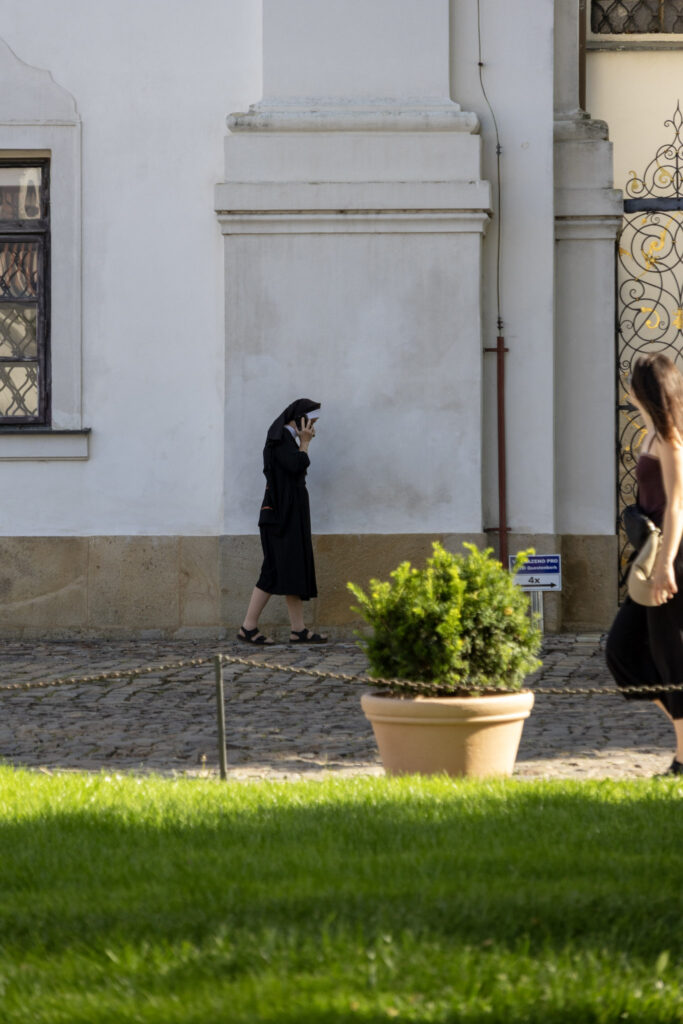

Address: Strahovské nádvoří 1/132 | Website: https://www.strahovskyklaster.cz/en
Bean Bag Chairs on a Rooftop: Prague’s Sunset Cinema
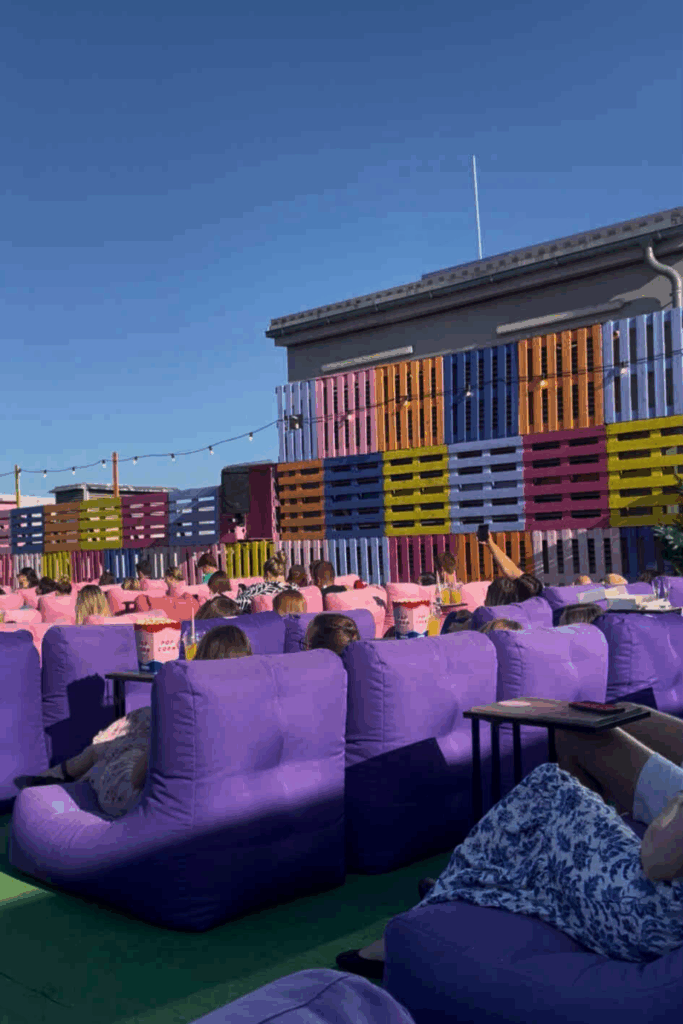
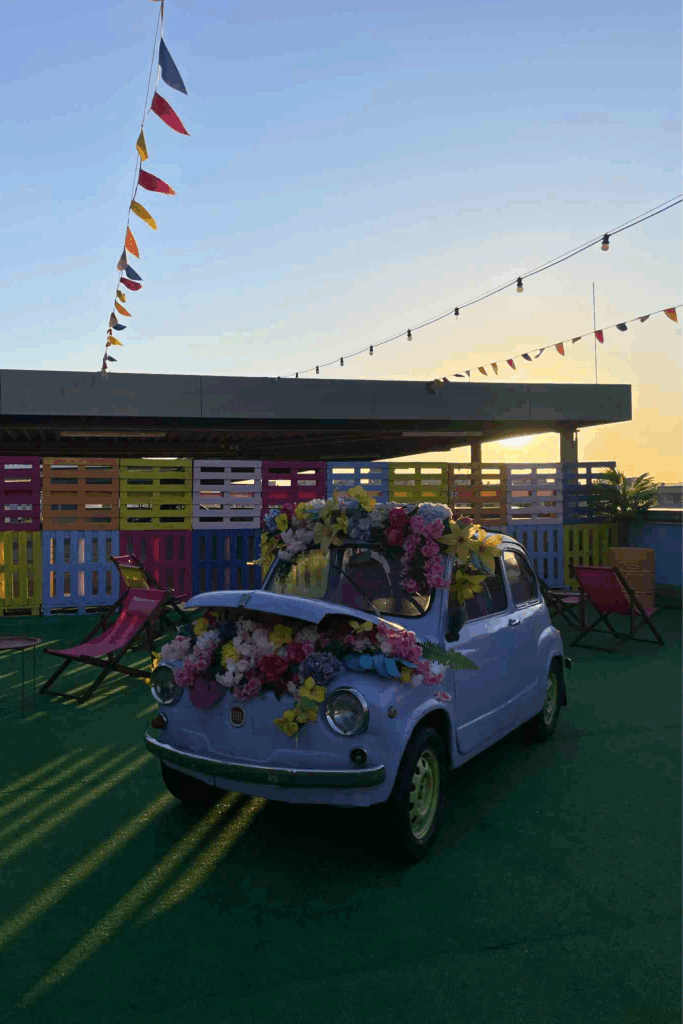
The further outstretched from Prague’s Old Town and main tourist hub, the architecture begins to look a bit drab – raw concrete buildings with lack of embellishments are a stark reminder of a not-so-distant communist past.
We hailed a taxi to the address for Sunset Cinema and ended up at what looked like a very ordinary shopping center. A few escalators later, we emerged into a riot of color that felt like capitalism on overdrive after decades of communism. Sunset Cinema bursts with personality: purple beanbag chairs, a powder-blue Volkswagen Beetle, and pink streamers transform the rooftop into Malibu Barbie’s penthouse. Guests sip Coca-Cola while watching English films with Czech subtitles. The night we went, they were screening 10 Things I Hate About You (1999). Niah and I laughed out loud while the rest of the rooftop stayed politely silent.
Sunset Cinema operates seasonally, with films showing regularly in the summer as well as Christmas specials.
Address: Na Pankráci 86, 140 00 Praha 4-Nusle | Website: https://sunsetcinema.cz/en/summer#
Prague’s Wes Anderson Moment: Hlavní Nádraží
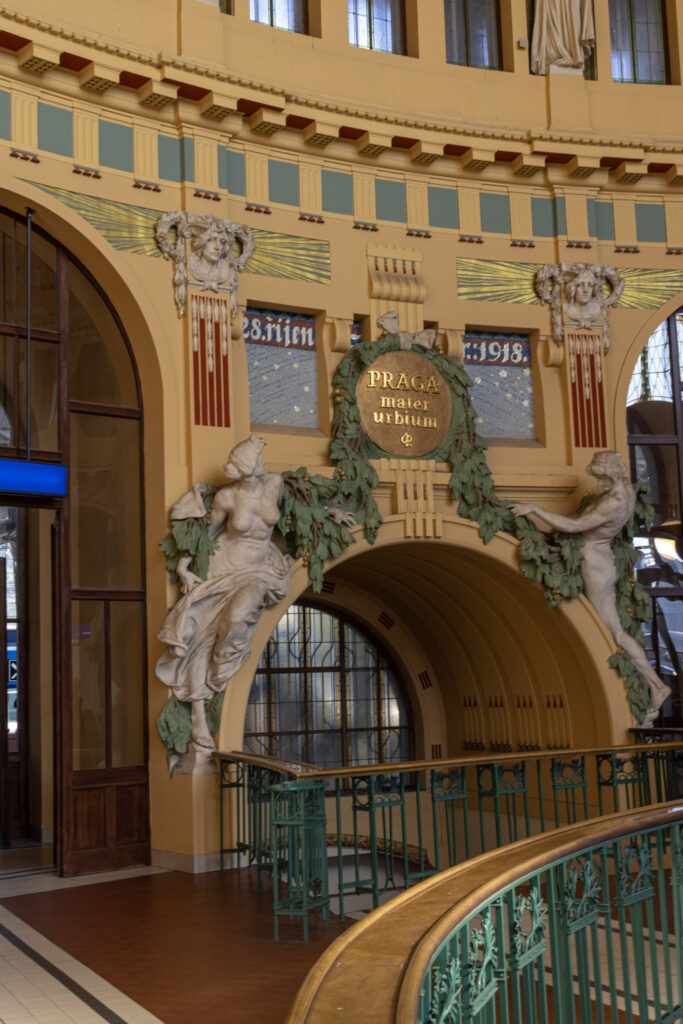
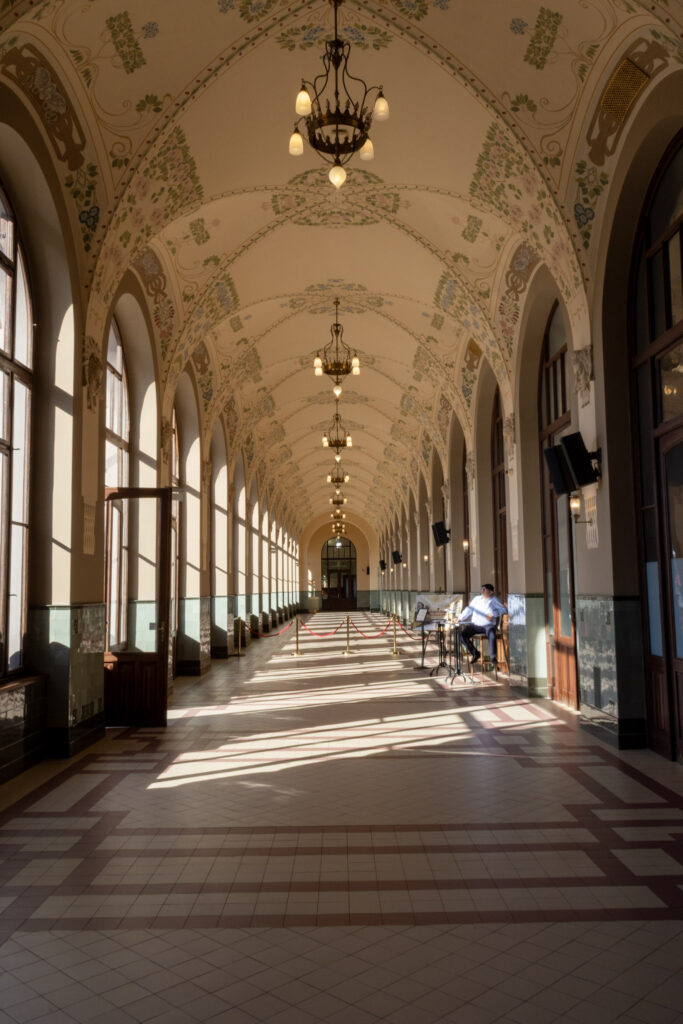
Setting foot into the circular dome of Prague Hlavni Nadrazi (also known as Praha hl.n.), the Czech Republic’s largest railway station, feels like how I imagine the set of a Wes Anderson film. Instead of salmon pinks as in the Grand Hotel Budapest or earthy greens of Moonrise Kingdom, Prague’s railway station opted for mustard yellow.
Even if you are not traveling by train, I highly recommend visiting this railway station for it’s awe-inspiring art deco, or even to sip a café at Fantova Kavarna. Rolling my suitcase in the crowd of hurried travelers, I took a double take at a monument of a door imprinted with childlike hand molds. With my camera packed neatly in my bag, I am today disappointed that I didn’t stop to take a photo. A quick online search of that eerie door on the train ride home informed me that it was built in honor of Nicholas Winton, who helped some 669 primarily Jewish children flee Czechoslovakia during the second world war. A statue of Winton also stands on platform 1.
Address: Wilsonova 8, 120 00, Vinohrady, Praha 2 | Website: https://www.cd.cz/en/stanice/praha-hl-n-/57076

What a wonderful article! Made me feel like I was there. Your description of the Jewish Synagogues and history gave me goosebumps! So glad you got to see it with one of your dearest friends!